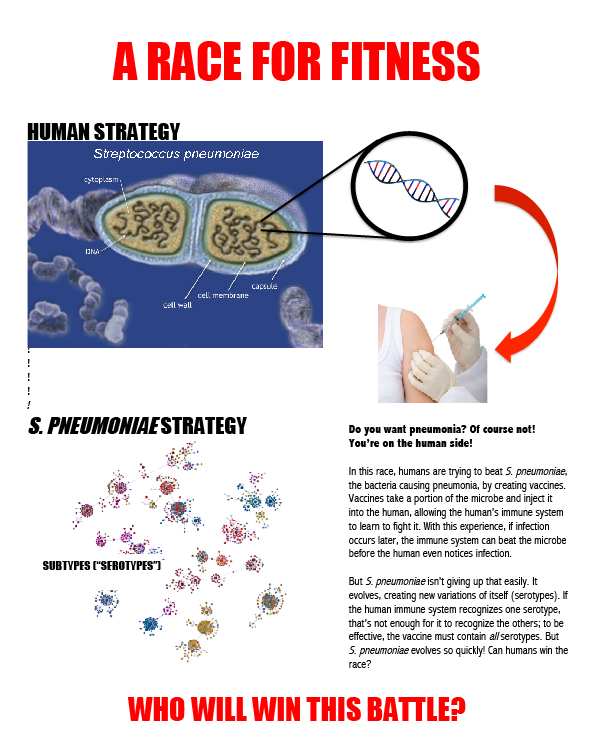Contributed by Jessie Barra, Reem Al-Atassi, and Najdat Zohbi
How can a single celled organism beat something so complex as a human being? It seems like an impossible task, but with the short life span of a single celled bacterium, changes in the genetic code can happen so fast that the human immune system can’t keep up. The bacteria, Streptococcus pneumoniae, better known as pneumococcus, has the ability to cause pneumonia and meningitis once it colonizes the upper respiratory tract, which includes the nose, mouth, and throat (Cobey, 2012). These two infections can be life threatening especially in children, young adults, and the elderly (CDC). There are over 90 different subtypes (known as serotypes) of this bacterial species that differ in their coating that surrounds their DNA (Cobey, 2012). As a response to the threat this bacterial species posed to the human population, a vaccine was created in 2000 called PCV7 that protects against seven serotypes of pneumococcal bacteria (later replaced by PCV13 in 2010 which protected against thirteen) and reduced the rates of disease. The problem with the vaccine is that it only offers protection from a portion of the many natural serotypes. The vaccine has therefore altered the likelihood for certain subtypes of the bacteria to survive inside its human host (Croucher, 2015). As the human population became protected against the seven serotypes represented by the vaccine, other versions of the bacteria replaced them as the cause of most cases of invasive disease (Flasche, 2011).
So, new serotypes decrease the effectiveness of these particular vaccines (Kyaw, 2006). More resistant serotypes have been shown to have tougher outer coatings that don’t cost much energy to make, marking a strategy of pneumococcus to linger in the nasopharynx (Weinberger, 2009). Serotypes that carry on undetected by the immune system have a clear advantage over those that the immune system notices. As a result, natural selection favors serotypes that bypass our immune defenses. We are left, then, with a biological arms race that is characteristic of co-evolution; as we fight pneumococcus through vaccines, the bacteria counters with stealth. Nevertheless, our immune system has an ace in the hole: special white blood cells (referred to as CD4+ TH17 cells) can fight pneumococcus even if it’s not detected normally. Essentially, these cells can decrease the colonization of even the stealthy bacteria (Li, 2012), offering insight into alternative vaccine design. In this instance of co-evolution, our ability to drastically affect the evolutionary response of pneumococcus reminds us that evolution can occur quickly. A common misconception is that evolution spans long stretches of time, but here, we see that this is not the case–evolution is not necessarily so gradual that we can’t directly influence it.
If you’re interested in perusing some pneumococcus primary literature, here are some great places to start:
Cobey, S., Lipstitch, M. 2012. Niche and neutral effects of acquired immunity permit coexistence of pneumococcal serotypes. Science 335: 1376-89.
Croucher, NJ. et al. 2015. Population genomic datasets describing the post-vaccine evolutionary epidemiology of Streptococcus pneumoniae. Sci Data 2:150058.
Flasche, S. et al. 2011. Effect of pneumococcal conjugate vaccination on serotype-specific carriage and invasive disease in England: a cross-sectional study. PLoS Med 8(4): e1001017.
Kyaw, Moe H., et. al. 2006. Effect of Introduction of Pneumococcal Conjugate Vaccine on Drug-Resistant Streptococcus pneumonia. New England Journal of Medicine 354: 1455-1463.
Li, Y et al. 2012. Distinct Effects on Diversifying Selection by Two Mechanisms of Immunity against Streptococcus pneumonia. PLoS Pathogens 8(11): e1002989.
Weinberger, DM., et al. 2009. Pneumococcal capsular polysaccharide structure predicts serotype prevalence. PLoS Pathogens 5(6): e1000476.
